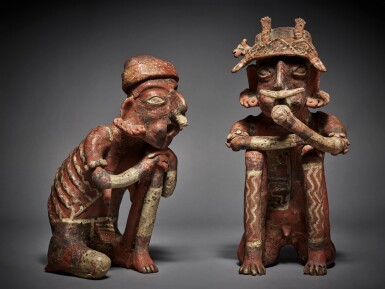Art of Africa, Oceania, and the Americas
Art of Africa, Oceania, and the Americas

Property from an American Private Collection
Nayarit Seated Emaciated Couple, Ixtlán del Rio style, Protoclassic, circa 300 BC - AD 300
Lot Closed
November 22, 07:21 PM GMT
Estimate
40,000 - 60,000 USD
Lot Details
Description
Property from an American Private Collection
Nayarit Seated Emaciated Couple, Ixtlán del Rio style, Protoclassic, circa 300 BC - AD 300
Male figure: inscribed in black ink on the proper lower right underside: "PRIMUS P208" [as best legible]; on the proper left underside inscribed in black: [partially illegible] "015 B / 500P"; inscribed in white on underside: "G68-037" [as best legible]
Female figure: on proper left backside inscribed in black: "A4015A / X500P" [as best legible]
Heights: female 13 3/8 in (34 cm), male 15 3/4 in (40 cm)
Ed Primus, Los Angeles, acquired in the 1960s
Stendahl Galleries, Los Angeles
Mr. and Mrs. Joseph Goldenberg, Los Angeles, acquired from the above in 1968
Stendahl Galleries, Los Angeles, acquired from the above
American Private Collection, acquired from the above in 2005
Stendahl Galleries, Los Angeles
Mr. and Mrs. Joseph Goldenberg, Los Angeles, acquired from the above in 1968
Stendahl Galleries, Los Angeles, acquired from the above
American Private Collection, acquired from the above in 2005
Male figure:
Richard F. Townsend, ed., Ancient West Mexico, Art and Archaeology of the Unknown Past, Chicago, 1998, p. 168, fig 1
Richard F. Townsend, ed., Ancient West Mexico, Art and Archaeology of the Unknown Past, Chicago, 1998, p. 168, fig 1
These brightly decorated Ixtlán del Rio figures are some of the finest of the emaciated couple style. They emit a compelling raw expressiveness and dramatic ceremonial moment by their hunched postures with their ribs gracefully modelled down their arched backs. The slender bodies are the result of ritual fasting which was accompanied by facial piercing, now showing as the swollen cheeks highlighted by geometric designs. Each figure has thin arms and legs drawn upward to help support their fatigued bodies.
Cheek piercing and subsequent fasting were rituals of mourning for the ancient Nayarit people. Ritual bloodletting by piercing one’s cheek with stingray or agave spines or sharp sticks was an important ritual to honor a deceased ancestor. Scenes of individuals with sticks piercing their cheeks are shown on anecdotal house and platform scenes. The significance of both men and women participating in such intense rituals attests to their complimentary gender status in ancient West Mexico.
The couple is further united in their exuberant body paint and jewelry ornaments. They share the embellishment of the cascade of multiple disc earrings along each lobe, beaded armbands and a large nose ornament. The female wears a patterned headband and the male holds a tubular implement to his mouth and wears the extended body of an animal as his headdress. Each of their bodies is covered in wavy and geometric designs.
The “extraordinary plastic and expressive power” of Nayarit figures of the Ixtlán style was deeply appreciated by Diego Rivera as shown in his murals and within his collection of ceramic art (see Barbara Braun, "West Mexican Art and Modernist Artists", in Richard F. Townsend, ed., Ancient West Mexico: Art and Archaeology of the Unknown Past, Chicago, 1998, p. 268; see also Townsend, ed., ibid., p. 174, fig. 11 for a highly similar couple).
Cheek piercing and subsequent fasting were rituals of mourning for the ancient Nayarit people. Ritual bloodletting by piercing one’s cheek with stingray or agave spines or sharp sticks was an important ritual to honor a deceased ancestor. Scenes of individuals with sticks piercing their cheeks are shown on anecdotal house and platform scenes. The significance of both men and women participating in such intense rituals attests to their complimentary gender status in ancient West Mexico.
The couple is further united in their exuberant body paint and jewelry ornaments. They share the embellishment of the cascade of multiple disc earrings along each lobe, beaded armbands and a large nose ornament. The female wears a patterned headband and the male holds a tubular implement to his mouth and wears the extended body of an animal as his headdress. Each of their bodies is covered in wavy and geometric designs.
The “extraordinary plastic and expressive power” of Nayarit figures of the Ixtlán style was deeply appreciated by Diego Rivera as shown in his murals and within his collection of ceramic art (see Barbara Braun, "West Mexican Art and Modernist Artists", in Richard F. Townsend, ed., Ancient West Mexico: Art and Archaeology of the Unknown Past, Chicago, 1998, p. 268; see also Townsend, ed., ibid., p. 174, fig. 11 for a highly similar couple).
